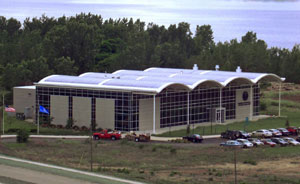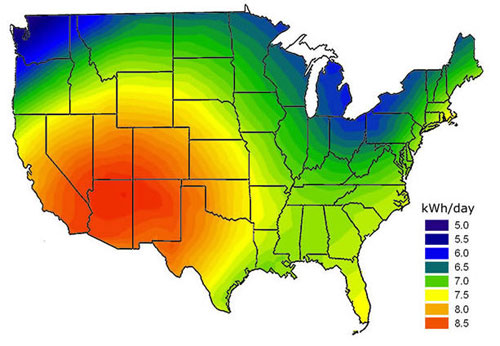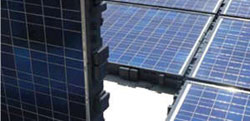Integrating Solar Electric Systems into Roofing Design
Using Building Integrated Photovoltaic (BIPV) Electrical Systems to reduce energy costs and contribute to a carbon neutral building design
This course is no longer active
Sponsored by Johns Manville Corporation
Design Parameters for Roof Mounted BIPV systems:
For many building types, BIPV roof mounted systems have started to emerge as the most popular, available, affordable, and effective solution. For a design project that moves in that direction, it becomes important then to understand the other parameters that will influence the BIPV design and final decision making process.
-
Owner / User Criteria: Very often, the motivation for including a BIPV system comes from the interest or requirement of a building owner or user. It is important to ascertain and understand what the specific goals and objectives are behind that motivation, just as with any design criteria. For example, is the objective to pay less for electricity or to avoid fossil fuel use or both? Government and defense agencies have been leaders in incorporating BIPV for quite awhile with a view to both of these long term benefits as well as the added ability to control their own electrical generation. Similarly, institutions with an educational or not-for-profit mission often see not only the cost savings, but also the educational and promotional aspects of installing a system. In these cases, they may prefer greater visibility and observation of the system. Commercial and industrial owners and users are typically more concerned with the economic rationale for the system as it relates to their stake in the building. If they intend to own and operate the building for a long time, their point of view is likely to be different than if they intend to lease it to tenants who pay their own utility costs. High-profile systems can also demonstrate the building owner's preference or requirement to provide an environmentally conscious work environment. It is important, then, to have the detailed discussions with the client over these goals and objectives while educating them on the options along the way. The resulting decisions and outcomes will directly affect the design process going forward.
Michigan Alternative and Renewable Energy Center (30kW), Grand Valley State University, Muskegon, MI was driven by owner criteria.
- Building and BIPV Electrical Requirements: As part of the electrical engineering work of a new or renovation building project, the total anticipated building electrical usage will normally be estimated. The design decision related to that result is to determine how much of the electrical load is intended to be provided by the BIPV system and for what purpose(s). For example, one owner may be interested in producing enough electricity to power only the lighting needs while another wants to meet 100% of the building needs. A key point, particularly in buildings where air conditioning is a driving electricity user, is the impact of peak energy shaving − if a user is able to keep the peak energy charges down by using the BIPV system instead of purchased energy on the sunniest, hottest days, then this should be looked at as a key electrical system requirement. Conversely, there are some situations where the requirement may be primarily to optimize the amount of electricity sold back to the utility grid. Once the electrical requirements and goals are clarified, then the engineering calculations can inform the preferred electrical output of the BIPV system.
- Available Sunshine: There have been plenty of studies and in place testing done to declare that PV systems work virtually everywhere in the US, even in the often cloudy parts of the Northeast and Northwest. The difference between those locations and the sunny Southwest for example, not only lies in the amount of typical peak sun hours per year but also some other factors such as the limiting effects of higher temperatures on the output of PV cells. The Florida Solar Energy Center is one of the organizations that has studied performance around the country. They have concluded that an identical 2 kW PV system size and configuration located in different regions of the US would achieve an average low of 5.0 kWh/day in the cloudiest areas and a high of 8.5 kWh/day in the sunniest. The implications? of these findings on the design of a BIPV system is to account for the regional variation by adjusting the size of the array or the angle of exposure to the sun or both.

The Florida Solar Energy Center has conducted a study to examine how a 2- kW photovoltaic system would perform if installed on a highly energy efficient home across the continental USA. As the image illustrates, solar photovoltaic systems work just about anywhere in the US.
- Available Roof Area: An obvious benefit or limitation to the size of a roof installed BIPV is the area of the roof that is actually available for the system. Specifically, how much of the roof is not being used for other purposes (e.g. mechanical equipment, stair towers, walkways, signage, etc.) and is not shaded either by those other uses or by other buildings or site features. A common rule of thumb used to estimate the physical space a PV system might need is that one square foot of PV module in bright sunlight will yield 10 watts of power. A 1,000 watt system (1 kW), however may need 100 − 200 square feet of area, depending on the type of PV module used and other factors that influence the performance. It will also be important to look carefully at the available roof space to determine the best way to fit the modules into an effective array. By looking at different options and alternative layouts for the roof design, it may be possible that there is either enough, an excess, or too little roof area to meet the stated goals and objectives of the BIPV system. In the latter case, obviously something will need to be adjusted. Either the goal will need to be paired back or an additional array elsewhere on the building or remote from it will need to be considered.
-
Roofing Membrane: While we have been focused on the PV system thus far, it is clearly important to remember that the roofing system still needs to function as a roof. That means that the integration of the PV must still allow for proper roof membrane installation, proper drainage, roof inspection and maintenance. The best available integrated systems avoid any additional penetrations in the roofing membrane thus maintaining the complete and warranted integrity of the roofing system. Part of the benefit of the PV array is to enhance and extend the life of the roofing membrane, so designing and constructing the total system to work with the roofing is an important part of the design.
Flat roof membrane system with integrated ballasted crystalline PV system avoiding roofing penetrations
- Construction Criteria: Other construction issues need to be considered, particularly for BIPV installations on existing buildings. For example, the weight of the roof mounted system will need to be taken into account. Most thin film systems are very lightweight and are likely not an issue. Crystalline panel systems will need to be looked at in terms what may be getting replaced, removed from, or added to the roof structure. For example, an existing building that has a ballasted built up roof system may already be supporting upwards of 10 pounds per square foot of dead load. The replacement may be a membrane roof that includes a crystalline panel system that serves as the roof ballast and weighs in between 2 and 6 pounds per square foot, thus providing a structural benefit. Other situations may not yield the same results however.
- Codes and Standards: As with most aspects of building design, there are national codes and standards that need to be consulted for the proper and safe design and installation of PV systems. Most of these will either be related to electrical requirements or the type of building envelope requirements that architects are already familiar with such as wind uplift, glass protection, etc. There are sometimes local ordinances that limit or restrict the use or location of solar panels of any type. These need to be reviewed during the normal code review process of the project.
- Local Utility Interface and Net Metering: In addition to the regular electrical design, it will be important that the electrical engineer for the project understands? and coordinates with the local utility company requirements. These can vary notably from place to place and should not be assumed or based on requirements from other locations. This will be particularly important if the building owner intends to take advantage of selling excess electricity back to the utility company through the process referred to as "net metering". Under federal law, and as explained by the US Dept. of Energy "utilities must allow independent power producers to be interconnected with the utility grid, and utilities must purchase any excess electricity they generate. Many states have gone beyond the minimum requirements of the federal law by allowing net metering for customers with PV systems. With net metering, the customer's electric meter will run backward when the solar electric system produces more power than is needed to operate the building. An approved, utility-grade inverter converts the DC power from the PV modules into AC power that exactly matches the voltage and frequency of the electricity flowing in the utility line; the system must also meet the utility's safety and power-quality requirements. The excess electricity is then fed into the utility grid and sold to the utility at the retail rate. In the event of a power outage, safety switches in the inverter automatically disconnect the PV system from the line. This safety disconnect protects utility repair personnel from being shocked by electricity flowing from the PV array into what they would expect to be a "dead" utility line."
 |
| Utility net metering allows electricity to be used either for a building or sent to the utility grid with the owner realizing credits against purchased power. |
Originally published in November 2009









